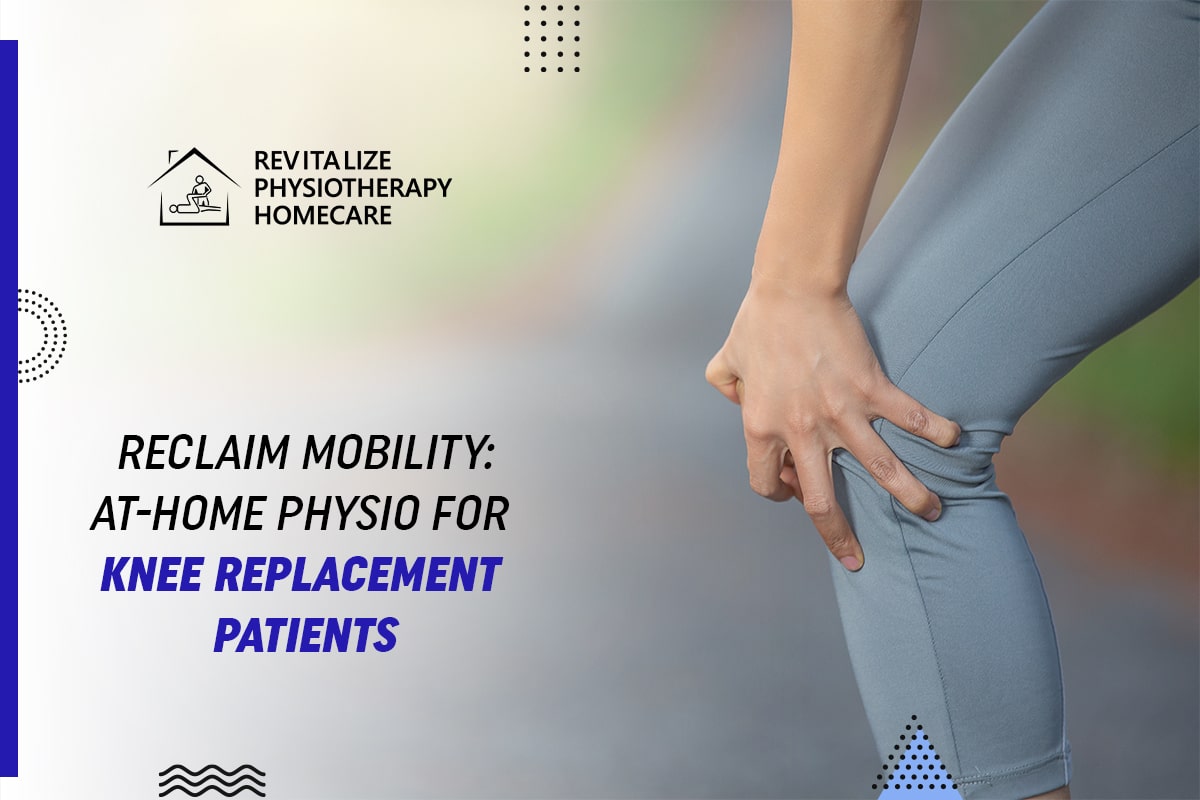Reclaim Mobility: At-Home Physio for Knee Replacement Patients
Regaining mobility following knee replacement surgery is an important step toward reclaiming your freedom and living an active life again. While traditional in-clinic physiotherapy is important, at-home physio activities can help you heal faster.
This blog discusses the benefits of at-home physiotherapy for knee replacement patients and provides you with practical exercises you may practice in the comfort of your own home.
Why At-Home Physio is a Game Changer for Knee Replacement Recovery
Traditional in-clinic physiotherapy sessions are useful. However, at-home physiotherapy provides a distinct set of benefits:
- Convenience and Flexibility: Plan your workouts around your schedule to avoid travel time and clinic appointments.
- Cost-effective: By combining in-clinic sessions with at-home practices, you can reduce the overall cost of recuperation.
- Empowerment and Control: Take control of your recovery by learning workouts that you can execute on your own.
- Improved Consistency: Repeating at-home exercises enhances gains made in physical therapy sessions.
- Pain Management: Certain exercises can help reduce pain and swelling, allowing for a more comfortable recovery.
Important Considerations Before You Begin
While at-home physio has many advantages, you should contact with your doctor or physical therapist before beginning any new exercise program. They can examine your specific needs and restrictions and develop a personalized plan for you. Additionally, make sure you have the proper equipment, such as pillows, rolled towels, and light weights (if indicated), on hand.
Getting Started with At-Home Physio Exercises
Here are some important exercises you can integrate into your at-home program, following your doctor's or therapist's advice:
Early Stage Exercises (Focus on pain management and gentle movement):
- Straight Leg Raises: Lie on your back, legs extended. Slowly elevate one leg straight up while keeping the knee straight. Hold for a few seconds and then gently lower. Repeat for the opposite leg. (2-3 sets, 10 repetitions)
- Ankle Pumps: While sitting or lying down, point your toes downward and hold for a few seconds. Then, flex your foot up and hold. Repeat this movement numerous times. (2-3 sets, 10 repetitions)
- Short Arc Quad Sets: Contract your thigh muscles (quadriceps) without moving your knee. Take a few seconds, then relax. Repeat the exercise. (2-3 sets, 10 repetitions)
Progression Exercises (Focus on improving strength and range of motion):
- Straight Leg Slides: Lie on your back, knees bent. Slowly glide one heel towards your buttocks while maintaining the other leg flat on the floor. Slide it back out softly. Repeat for the opposite leg. (2-3 sets, 10 repetitions)
- Heel Slides: Sit in the chair with your feet straight on the floor. Slide your heels as far away from you as is comfortable, then slide them back in. Repeat this movement numerous times. (2-3 sets, 10 repetitions)
- Calf Raises: Hold for a few seconds before slowly lowering down. This exercise can be performed with or without support. (2-3 sets, 10 repetitions)
Advanced Exercises (Focus on building strength and stability):
- Step-Ups: Use a solid chair or a step platform. Step slowly onto the platform with one leg, then bring the other up to join it. Step back down softly. Repeat for the opposite leg. (2-3 sets, 10 reps per leg)
- Wall Squats: Stand with your back to a wall and your feet shoulder-width apart. Slowly slide down the wall, as if you were sitting in a chair, maintaining your back straight and your core engaged. Hold for a few seconds before slowly pushing yourself back up to the starting position. (2-3 sets, 10 repetitions)
- Side Leg Lifts: Lie on your side, hips stacked, one leg on top of the other. Slowly raise the top leg a few inches, pause for a few seconds, and then drop it back down. Repeat on the other side. (2-3 sets, 10 reps per leg)
Remember:
- Listen to your body: Pain is a cue to quit. Take breaks and vary the intensity of your exercises as necessary.
- Maintain proper form: To optimize benefits and avoid injury, be sure you are executing the exercises correctly.
- Consistency is key: Regular practice is required for optimal healing. Aim for at least 2-3 20- to 30-minute sessions every day.
- Progression Tips: As your strength and flexibility improve, gradually increase the difficulty of your exercises. This may involve:
- Increasing repetitions or sets.
- Using light weights (with your therapist's permission) for exercises like leg lifts.
- Increase the height of your step-ups or wall squats.
- Holding exercises over extended periods of time.
- Balance Exercises: Include balance exercises in your routine to increase stability and prevent falls. Examples include standing on one leg for longer periods of time, walking heel-to-toe, or walking backward (with caution and support if necessary).
- Stretching: Regular stretching helps to preserve your knee's flexibility and range of motion. Include gentle stretches for your hamstrings, quadriceps, and calves after your workout.
- Additional Resources: In addition to the activities listed above, look into online resources for knee replacement therapy. Many physical therapy clinics and internet platforms provide video demonstrations and instructions for safe and effective workouts.
Remember that safety is paramount. If you suffer any pain, swelling, or discomfort that goes beyond usual post-operative soreness, stop exercising and contact your doctor or therapist right away.
Beyond Exercises: Optimizing Your Recovery at Home
While at-home workouts are important for healing, here are some more tips to help you progress:
- Ice Therapy: Use ice packs on your knee for 15-20 minutes at a time, several times a day, to reduce swelling and pain.
- Heat Therapy: After the initial inflammatory phase, heat therapy can assist relax muscles and increase flexibility.
- Healthy Eating: Eat a well-balanced diet high in fruits, vegetables, and whole grains to encourage healing and supply your body with the resources it requires to rebuild.
- Adequate Rest: Allow your body enough rest and recuperation time to repair tissues and avoid weariness.
- Positive Mindset: Keeping a good attitude and focusing on your efforts might help you heal faster.
Conclusion
Knee Replacement Physio at Home allows you to actively engage in your recovery following knee replacement surgery. Incorporating these exercises and advice into your daily routine will help you regain strength, flexibility, and independence in the comfort of your own home. Remember, consistency, appropriate form, and open communication with your healthcare team are essential for a successful recovery. If you have any questions or concerns, contact your doctor or therapist. With effort and the correct equipment, you may restore your mobility and resume the activities you enjoy.
Revitalize Physiotherapy and Homecare specializes in personalized at-home physiotherapy programs to help you recover effectively and comfortably. For more information or to schedule an appointment, please contact us at 905-452-0222 or email us at revitalize@physiocare.com.




